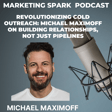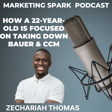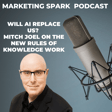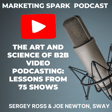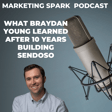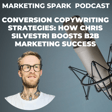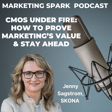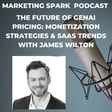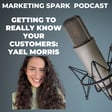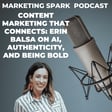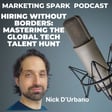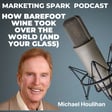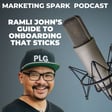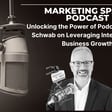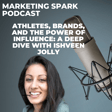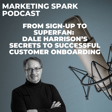Become a Creator today!Start creating today - Share your story with the world!
Start for free
00:00:00
00:00:01

Walnut.io's Journey from Idea to $56-million in Venture Capital
What's it like to operate a red-hot startup?
What's it like to raise $56-million in venture capital in a relatively short period of time?
In this episode of Marketing Spark, Walnut.io CEO Yoav Vilner talks about the interactive demo software company's rapid growth and how it raised major venture capital, including a $35 million Series B round in January.
Yoav and I also talked about:
- How B2B SaaS companies can attract their first 100 customers
- When sales teams should be scaled.
- When to hire your first full-time marketer and what type of marketer to hire
- The new world of networking.
Transcript
The Excitement and Challenges of Entrepreneurship
00:00:05
Speaker
Startups are exciting creatures. It's compelling to identify a problem and build something innovative and impactful. It explains why entrepreneurship is positioned as sexy and irresistible.
Yoav Billner on Startup Strategies and Mentorship
00:00:18
Speaker
But growing a business is hard work, teeming with challenges, hurdles, and surprises. You need to deal with the unexpected and follow a roadmap for success while still being agile and opportunistic.
00:00:31
Speaker
On today's podcast, I'm talking with Yoav Billner, co-founder and CEO of walnut.io, which helps companies easily create personalized interactive demos. A mentor, entrepreneur and marketer, Yoav advises startups and accelerators on how to attract customers, build relationships, establish a category and raise capital. Welcome to Marketing Spark. Thanks for having me.
How to Build a Strong Team and Validate Ideas
00:00:56
Speaker
It's arguably never been easier to start a B2B SaaS business. What's your advice for entrepreneurs thinking about launching a business or entrepreneurs running an early stage startup?
00:01:10
Speaker
I would first advise that you kind of look for the right people even before you think you have the best idea in the world. If you don't have a co-founder yet, but you have a good idea, you should probably flex and look for someone that will relate to what you want to do first and have a great chemistry with and share the DNA with. If you have a co-founder already, then your first two or three employees would dictate your success or failure within the first couple of months.
00:01:38
Speaker
Always put the people in front of everything else. I think that's the best thing that you can do. Also, make sure you focus on validating your idea, not just because VCs and investors would expect you to, but because you don't want to spend a decade of your life building something, only to find out your actual market doesn't even need.
Why Do Startups Fail?
00:02:04
Speaker
That's another critical first step.
00:02:07
Speaker
It's an interesting comment because CB insights has a long list of the reasons why startups fail and topping the list. One of the biggest reasons is that there is no need for the product. And I always find that interesting and troubling because why would an entrepreneur build anything, spend so much time on developing a business when there's no demand for it? Why do you think that happens? And how does it relate to your philosophy of
00:02:36
Speaker
of having the team and then finding a good idea and then validating that. Yeah, sometimes people rush into building a product they think is great, but the world will not care what you thought personally. So you have to do something the market needs, not only because you think it's a cool idea. The second thing, when you interview your target audience, let's talk like B2B, when you start interviewing people, you will hear a lot of very excited responses.
00:03:05
Speaker
When the moment comes and when you actually expect them to pay for it, they're not going to be there. So you have to be very mindful of not just following like five or six positive comments you've got about what you do. You have to talk to dozens of people from different companies, different size companies and different countries and really do a good job at it.
00:03:28
Speaker
How do you know if your idea has legs? We all have to go through the validation process. It's one thing to have this amazing idea, or at least an idea that you think is amazing. But what are the steps that you have to go through to make sure that the idea actually has legs? And is there rules in terms of the number of people you need to talk to or the amount of time you should spend before you decide, yes, I think we're on to something? And what are the signals that, yes, this is an idea that's worth pursuing?
00:03:59
Speaker
I would say that if you're in B2B, dozens and dozens of people, if you're in B2C, then hundreds, founders used to think that if 10 people tell them it's a great idea, then jackpot
00:04:14
Speaker
But again, if you have to think about people either not being totally honest with you and they want to bum you out, you know, you're grabbing coffee, they don't want to tell you your idea sucks. So they'll tell you that it's good. But you have to speak to strangers, not your friends, not your colleagues, and kind of get a lot of different reactions. Once you've crossed the chasm from idea to product, you've validated your idea.
00:04:43
Speaker
You develop your product, in this case, B2B SaaS software. The big challenge that a lot of entrepreneurs run into is generating demand or interest in the product. So they're out there, they're busy, they're trying to sell, they're trying to do marketing. And despite their efforts, it's almost like they're spinning their wheels. They're not gaining any traction.
Acquiring Initial Customers and Building Credibility
00:05:03
Speaker
They have a hard time convincing anyone that the product is worth pursuing. There's lots of reasons for that. Maybe there's a lot of competition. They have no track record.
00:05:13
Speaker
Maybe it's a time in the economic cycle when demand is a little bit soft, but regardless of the reason, there's no customer acquisition and those first hundred customers or 50 customers are critical. How do you get those first hundred customers? And maybe we can even take a step back. How do you get those first five or 10 customers? Those are the ones that are just taking a leap of faith because
00:05:37
Speaker
They have no social proof that you can't really give them any other examples of people who have gone before them. What's your advice about that? Yeah, your first customer would probably be a friend or a workplace of a friend. Every one of us can get a first customer. The first five is more difficult.
00:05:56
Speaker
You have to go beyond your circles. Just show your MVP to a couple of companies and offer them to be design partners, which is kind of... You don't need to monetize it yet. You just need to show investors there's interest from the market. So tell them we build it out for you and you don't need to pay for it. And then the next two or three customers will be design partners.
00:06:18
Speaker
And you would go and grab their logos and go to more serious companies that can pay for it. And it's like an interesting climbing up the stairs one step at a time. Eventually, when you've already hit like a double digit number of customers, that's where things usually take a nice turn. Depending if you're building a valuable product, you can also take a turn to the wrong side. But if you're building something nice, then that's where you're going to see it kind of taken off.
00:06:47
Speaker
You would want to invest in content and a little bit of PR a little bit early on so people can believe you and trust what you're doing. Like you said, if you don't have the experience or the background, you would have to convince them through other sources that you're valuable. And so press coverage usually does the trick that you can send over to prospects. And be very clear about the message and the problem you want to solve. So initially, you're looking for guinea pigs.
00:07:15
Speaker
for lack of a better word, people who will invest their time to reap the benefits of your product. So you're looking for them to volunteer their time. The question I have is, how do you make that happen? How do you find those people? Is it word of mouth? Do you go through your networks? Because we have to look at many companies, it's an investment. Regardless of whether they're paying any money, they have to invest something. You better find somebody who really needs your product. What's the process for that?
00:07:45
Speaker
Right. That's a good way to find out if you're building something the world needs. If you can't find people that want to get the value from your product for free.
00:07:54
Speaker
then something's just off or either you're talking to the round go to market and this is completely, you know, that's a mistake we can all make early on. You can switch personas in the organization and see if there's a better reaction. But if you take your MVP to someone, you know, VP, whatever, let's say a VP, product marketing in some organization because that's your target audience.
00:08:16
Speaker
And they tell you they don't want to devote a little bit of their time to get free value from your product, then you're not building the right thing at the right time. And so you'd have to pivot a little bit. Eventually, you need to find people that will want to devote a bit of their time. For us, it's a demo platform for sales teams and sales leaders. So when we just started talking to VP of Sales and we spoke to like 60 or 70 of them, that's when a wait list started to form.
00:08:44
Speaker
And when we saw the weight leaks keep growing and growing, then we knew that it's a real problem. People need help. It's interesting. In the case of Walnut, describe to me those early days when you had this idea of an interactive demo, you started, how many people did you reach out to? What was the initial reaction? And how did you find those design partners?
Gaining Traction with Market Timing and Product Hunt
00:09:05
Speaker
Yeah, so with Walnut, I say that the styles aligned in ways that I've never seen much in my life, including helping 600 startups as part of running an agency once many years ago. Everything just kind of aligned.
00:09:20
Speaker
The first batch of 60 or 70 VP sales we spoke to said we would really pay for it. They even named the price that they want to pay for it when it's ready because they had huge problems of friction between salespeople and developers and product and people trying to help or interfere with the demos that salespeople are doing.
00:09:41
Speaker
And we told them we can empower your salespeople to create their own demos and manage it and run it and personalize and everything. And so it was a very swift beginning. And then we launched on product hunt to kind of test the waters. And that grew to be the best hunt of that week with being nominated for their annual awards. And it got exposed to thousands of sales leaders. And at that point, we had 700 people on the wait list.
00:10:10
Speaker
and everything just kind of took off. We could all be so lucky as entrepreneurs to have that happen. One thing I didn't want to pick up on is you mentioned PR as a way to provide customers with some confidence in you as the entrepreneur and the company. And having been a journalist for a long time and having dealt with a lot of PR people,
00:10:33
Speaker
From the outside looking in, it sounds great. Getting media coverage, being written about in TechCrunch sounds wonderful, but we all know the realities of PR. It's really hard to break through. It's a very noisy landscape. It's hard to attract the spotlights, especially if you're a small company with very few customers and a non-existent track record. So how do you leverage PR? How do you create a story about yourself that's newsworthy when
00:11:02
Speaker
You haven't got a long track record and there's really not a lot to write about. Yeah, that's a great question. If you don't have the right connections, you're in a problem because you can't even afford to hire a PR agency yet. You're at seed stage. It doesn't make sense.
00:11:16
Speaker
If you want to get coverage, if you think your story is very timely, because we launched when remote sales became a thing during the first COVID lockdown, and it was super interesting. And then the public saw that we're building an editor for demos. And then they said, this is like Wix, but for demos. And then the headlines were like a Wix for demos type of thing.
00:11:44
Speaker
So we kind of danced around that and then we raised our first 2.5 million seed which is now considered to be low seed and most journalists would not cover but it was still at the beginning of COVID it was sufficient for an announcement. So you need to get all kinds of triggers and hooks but eventually like
00:12:05
Speaker
Try to reach out to journalists on your own, whether on Twitter or anything, and offer them a story. A lot of founders are kind of afraid of that. They're afraid of this whole thing of talking to journalists. They're like, if I don't have a CMO, I don't know how to do that. But I think journalists really appreciate talking to the founder and CEO. So just try it out. If you've raised some funds for a seed round, then I think it's good enough for a first announcement.
00:12:33
Speaker
I found that as well when I'm dealing with clients is they want to hire a PR person or in some cases they want me to reach out to a reporter or a blogger. And I, and agencies and people like myself, consultants like myself, we don't have the street cred. We don't have the credibility. Entrepreneurs, on the other hand, they're authentic. They're, they're doing it. They're the ones, it's their time and money and energy on the line. And I, and my advice to a lot of entrepreneurs is, is go out and talk to reporters. Reporters like talking to the source of truth.
00:13:03
Speaker
They want real world examples. They want to hear firsthand about what's going on with startups and what entrepreneurs think of trends. So I think that's great advice. Once you've got product market fit, once you've validated your product, once you've got a few guinea pigs or customers in the mix, what's the next step?
When to Scale Sales and Marketing in Startups
00:13:24
Speaker
Because some companies will just hire a sales team and they'll go hard hoping that the product sells itself
00:13:30
Speaker
as long as you can reach out to enough people. Other companies leverage marketing because they want to build a brand and some companies do both. What's your advice? Is there a general rule of thumb of when things should happen or whether things should happen at the same time? Because for a lot of entrepreneurs, it comes down to priorities, competing priorities.
00:13:49
Speaker
Yeah, most of them remember way too late to handle, first of all, to handle any of what you just mentioned. I've seen startups that were kind of successful, but they forgot all about a CMO or a VP of sales up until the second or third year and things started to gradually crash. So you have to focus on your brand, your positioning, the value proposition.
00:14:13
Speaker
from day one, I think, even if there's not a lot of budget, just start working on your brand. The thing is, it's a slow process. And the other thing is your competitors are probably going to beat you to it. For us, we've made, by the way, a very odd decision of bringing on a VP of Sales as our second employee.
00:14:32
Speaker
We did not have a full product to even sell, but he's also our target audience. We also use him to help us shape the MVP of how VP of Sales would want to use our product. That was a very smart move. In between, he built out our pipeline and leveraged his network and that was a very smart move for us. What about marketing? When did marketing become part of the Walmart mix?
00:15:00
Speaker
Um, so our 10th employee has been a head of marketing and it's also super early on. Like usually I'm not saying bringing a full full-time head of marketing when you're 10 people, it's usually the size where you're still building out your product, trying to experiment, experiment the direction with your design partners. Um, but it's like, my, my personal background is marketing. So it was my, it was my personal hunch that we need to get it early and, you know, get it right.
00:15:27
Speaker
And it really paid off. Like we're considered to be one of the best brands right now in B2B sales. And we're getting hundreds of leads each month, just of different initiatives that we have around brand. And so it paid off. Timing for marketing is always an interesting question, particularly when it comes to hiring a full-time employee. Many of the companies that I work with have at best a junior marketer because they're not quite sure that they're ready for marketing or they don't have the confidence in marketing.
00:15:56
Speaker
or they don't have a budget for marketing. And my question to you is, how do you know when the time is right to hire that first full-time marketer? And as important, what kind of skills should they have? Do you hire a generalist who is a jack of all trades or a jill of all trades and they can do anything? Or do you hire a specialist who can help you leverage a particular channel or a particular type of marketing?
00:16:22
Speaker
Yeah, I would first say that kind of varies according to your specific industry and product and everything. Some industry is required to be more loud and better with content and build a brand early on. With some type of startups, you could be better off building your technology in the garage for the first year. But let's say you're part of an industry that's competitive and you want to go out there and go above the radar.
00:16:48
Speaker
I would say anywhere between 10 or 15 first employees, that's when you want to squeeze in that first marketing. I think the idea of a generalist could be good. If there's a medium-level generalist not hoping to be CMO,
00:17:04
Speaker
can handle the social and the branding and the website and the first PPC campaigns, handling your PL team and everything. Even for most founders, that is too good to be true. Usually they would not find even that guy early on until they raised sufficiently more funds and then they can pay for the more expensive people. What about the flip side when it comes to sales? Your first hire, one of your first hires with the VP sales,
00:17:34
Speaker
How quickly should B2B SaaS startups scale their sales? Because if you've got demand, I guess you can handle more BDRs and you can hire more salespeople and they'll have enough to do. But is there a rule of thumb in terms of how quickly you should build out your sales team?
00:17:50
Speaker
I'm talking here as if you're not a sales startup because we are and so we had to bring them on super early because it made sense. If you're not a sales startup, then I would say the minute that you feel you've hit a little bit of a fit, of a market fit, if you feel that you've spoken down to 100 customers and something will actually happen, like you're
00:18:12
Speaker
product can do something, then you should start with your first time, with your full-time salesperson.
Balancing Capital Raising and Business Operations
00:18:21
Speaker
If you feel your product is not there yet, your design partners are disappointed, there's too much of a roadmap until the moment you actually feel it's time to launch and everything, then you should probably hold off a little bit more. What was the journey like at Walnut? How did the first VP of sales
00:18:37
Speaker
Tremendous demand or interest in the product. So there was a giant pipeline. Did you scale up quickly or were you a little bit more pragmatic? It was very fast. We started our first year with a couple of design partners, raising 2.5 million seed round and seeing where it goes. And we ended our first year with over 100 customers, including Fortune companies, and raising a total of $56 million.
00:19:04
Speaker
Incredible. Maybe we can shift gears a little bit and talk about fundraising. Raising money is very exciting because for entrepreneurs, it's seen as a validation of all the hard work that they've done and their teams have done. But it also takes a lot of time and effort. What's your advice, having gone through it, having raised so much money? What's your advice on how entrepreneurs should raise money? Because it can be very distracting.
00:19:29
Speaker
You can often be out of the business while you're trying to talk to investors and raise capital. And there can be some downsides if you find that you're not raising the money that you need. If you're an entrepreneur and you're looking to raise money and if you're the CEO and you're the visionary, how do you manage the balancing act between raising money and running your company? It gets very distracting. And from the moment that you're gone online and above the radar,
00:19:57
Speaker
Let's say you've even announced your first one or two million dollars of investments. That's when they go after you like the VCs and the funds and the angels investors and they would target you as a good lead and they would ask for your time. And then you'd have to think if this is worth my time now, because the more you answer that you're not raising funds right now, the more
00:20:19
Speaker
the more they will keep trying and following up. Assuming you're a good team with a good product, right? People are not just wasting time on bad investments, but if you're a good deal, then they're going to keep trying and it's never ending. Like it's a black hole, doesn't end. Every time you think you've finished talking to investors, a new week begins and people reach out. So this is something you should be mindful. If you really don't need money for the next six months or eight months, like you don't need to talk to anyone.
00:20:49
Speaker
You'll just be wasting your time and you're giving investors some data points about where you are business wise. And you have to think if this is the right call for you, maybe it's not the right move right now.
From Seed to $56 Million: Yoav's Rapid Growth Journey
00:21:00
Speaker
Maybe it's a, maybe it's an investor that's been working with a competitor and you know, he's just trying to sniff around. So only do it like a couple of months before you really have to, and only do it with funds that you think will be valuable to you.
00:21:15
Speaker
So what was your experience like? You did that initial 2.5 million seed round. In the scheme of things, it's relatively small. All of a sudden, the company gets red hot. You've got this giant pipeline with hundreds of customers. I suspect that VCs started knocking on your door. How did you go from a seed round to raising $56 million? And how hard was it on you personally to be involved in that process and raise that much money? Everything is very emotional.
00:21:45
Speaker
hard and easy and good and bad all at once because if you're on a roll or, you know, like you said, a hot topic, then you're going to get everything inbound, but you just have to decide.
00:21:58
Speaker
Who is worth your time, but also then you can decide and it doesn't work out and the terms don't work out and you've wasted weeks of your life, like anything can happen. For us, it was like starting with a 2.5 million seed, going above the radar, making noise, being the first top rated product and product hunt, getting double digit press articles in our first couple of months.
00:22:19
Speaker
growing the waiting list to 700 companies. That's when we got to extend our seed to 6 million because there was a lot of inbound demand of amazing investors from Silicon Valley. And so eventually it was 6 million seed. And a couple of months later, we were a commercial with a couple of impressive clients and we've done our 15 million Series A. And a couple of months later, over 100 customers, lots of engagements and 35 million Series B.
00:22:46
Speaker
So the question that I've always wanted to ask a CEO who raises a lot of money, once you get all that money in a short period of time, what do you do with it?
Managing Fast Growth and Company Culture
00:22:57
Speaker
Obviously, the investors want you to move fast. They want you to hire fast. They want you to build a pipeline. They want you to build out the structure. Do you put the money in the bank for a while and you think about it, or do you just start executing on the plan that you've had that accompanies your fundraising activities?
00:23:17
Speaker
I think the smartest thing I've done is bringing a full-time VP of finance to help me out with all of this planning and a VP of people because growing fast, if it can hurt anyone, it's your people. You have to do this more than wise and keep your DNA.
00:23:34
Speaker
You know, so people are going to be bummed out. You haven't promoted them. You've brought on some more experienced people from the outside. Like when you grow that fast and you grow like a startup that's been alive for like five or six years, but in under two years.
00:23:49
Speaker
that can reflect a lot on the people. So we try to get everything right with my management team. And you have to spend the month like theoretically, you have to spend the money to grow. But now there's also kind of a switch in mindset ahead of the recession. I don't know when it's published, but the recession that's going to happen. And so you have to focus not just on growth with your money, but also on being efficient and getting revenues
00:24:16
Speaker
switching gears a little bit, there's a lot of talk these days about B2B SaaS companies building a technology category.
Establishing a New Technology Category
00:24:25
Speaker
And I'm curious from your perspective, what does that mean? Is it important? And if you do want to build a category, how do you do that? What are the key steps? I think eventually every startup describes themselves as as if they were building a category, but it's not often true. Like for us, it's likely been true because it really did not exist before.
00:24:46
Speaker
Like we were competing with brick and mortar solutions and PowerPoint presentations and videos and stuff. And so I've seen it happen really fast from talking about it and hearing it's a nice idea up until the point where you have hundreds of inbounds and Gartner's writing a blog post about your industry. And I've seen it happen real fast. I think the main point is trying to be first to market, trying to be the first one to announce what you do. And so the market will appreciate
00:25:14
Speaker
that you've come up with at first and then establish yourself with a lot of presence. The more followers you have on LinkedIn and the more content that you have, the more educating content that you produce and thought leadership pieces and all of that kind of connects into a huge puzzle that says you're dominating this category.
00:25:39
Speaker
The other thing I wanted to talk to you about when we were trying to arrange this interview is one of the topics that you were focused on is networking.
Networking in the Digital Age
00:25:47
Speaker
And I found that really interesting over the last two years is that networking has changed the days of going to conferences.
00:25:55
Speaker
and meetups and coffees and dinners, that all disappeared. But obviously networking is still important. A lot of it happens over Zoom or over things like this. As an entrepreneur who's trying to leverage networks, because it's important to sort of build up that network, how do you do it these days? Conferences are coming back, fortunately, slowly but surely. But what's your approach to networking and how do you do it effectively and efficiently so that you can build a network that works for you?
00:26:23
Speaker
Yeah, that's a great question because sometimes it's just remote and digital. Sometimes, like you said, it's in the real life and it's really hard to tell what's going on these days. If you have a strong presence online, I think it really reflects on the offline. I work a lot on the content that I provide and share on my LinkedIn.
00:26:47
Speaker
and everywhere else. And podcasts, by the way, I get invited often and I gladly take it. And then I go on to actual events and you actually see people know who you are and know the tone of voice that you have and the positioning that you try to own. And there's a lot of correlation.
00:27:07
Speaker
in between. I would say the more engaging content you share, like let's even creating a podcast like you're doing or just participating or a blog or a, you know, video series or of course that raising a lot of money never hurts your, hurts your efforts, right? Of being, of being a tech figure. But even before that, if you, if you dominate a specific topic, then it's really going to reflect on the real life events and the real life network. We've teased over the last
00:27:37
Speaker
28 minutes at Walnut, but never really talked about what Walnut does and who it
Benefits of Walnut.io's Interactive Demo Platform
00:27:42
Speaker
serves. Perhaps we can take an opportunity to give me a mini sales pitch on walnut.io.
00:27:48
Speaker
Yeah, for sure. So we're letting sales teams and marketing teams create interactive demos, personalized demos. They help them put the prospects in the center so no two prospects are alike and they should probably get different experiences. You can embed it on your website so you don't even have to take the Zoom call. You can just send it to a million prospects.
00:28:07
Speaker
You can walk them through the interactive demo. You can get insights and conclusions and, you know, analytics into the process. You can collaborate with your appeals and salespeople on your company. And eventually you can call it, you know, you can look at it from different angles. If it's product-led growth that we're allowing, if it's just personalization, if it's just making B2B sales less difficult, this is usually the core of what we do. Where can people find more information about you and Walnut?
00:28:37
Speaker
I'm everywhere. It's really hard to ignore. But walnut.io and our different handles on LinkedIn and Twitter and my own LinkedIn, I'm always available there for feedback and messages. Awesome. Thank you for all the great advice and insight.
00:28:51
Speaker
And thanks everybody for listening to another episode of Marketing Spark. If you enjoyed the conversation, leave a review, subscribe via Apple Podcast or your favorite podcast app, and share via social media. To learn more about how I help B2B SaaS companies as a fractional CMO, strategic advisor and coach, send an email to mark at markevans.ca or connect with me on LinkedIn. I'll talk to you later.

